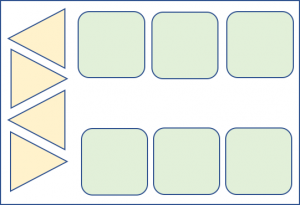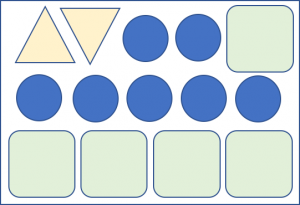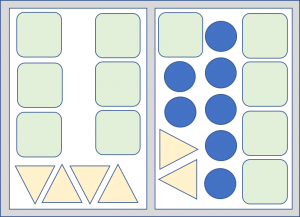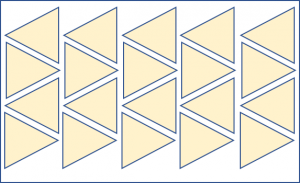Die cutting
For die cutting, we start from an existing die cutting-form with a fixed number of replicas for 1 or more article forms. An article form is an identification of the form one obtains by die cutting.
For example: the die cutting form X1 contains 4 triangle replicas and 6 square replicas, while the die cutting form X2 contains 2 triangle replicas, 5 square replicas and 7 circle replicas.
Die cutting form X1
Die cutting form X2
The actual version of the die cutting engine operates with 1 article form per die cutting form and 1 die cutting form per imposition. For the future we'll foresee more article forms per die cutting form and more die cutting forms per imposition.
2 die cutting-forms together in 1 imposition
The simplest case with 1 article form per die cutting form, is for example one with 20 triangle replicas.
Die cutting form with 1 article-form and 20 replicas
Let's assume we want to produce five different triangle orders. Depending on the requested quantities, 1, 2 or more impositions will be obtained.
Workflower developed its own die cutting algorithm (the DG-algorithm), whereby orders may be spread over multiple impositions. At the same time, impositions will be split whenever this is cost-optimal. This, is contrary to the classical punching and cutting work, whereby 1 order only appears in 1 imposition, for practical production purposes.
The automatic spread of orders over multiple impositions allows to limit the overproduction drastically. The difference may be an order of magnitude of 6 to 10 percent.
EXAMPLE
As an example we give the two results for the same case, the first without spreading of orders, and the second with spreading.
The case contains 80 orders and a fixed die cut form of 112 replicas. The result of the normal ganging-engine (without spreading) consists out of 2 impositions and 11.917 sheets (waste not included). The (unavoidable) overproduction is 14,94%.
die_cutting_demo_without_spreading_result
The result of the DG-algorithm also consists out of 2 impositions, but now with only 11.000 sheets and an overproduction of 6,39%.




